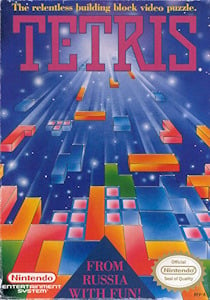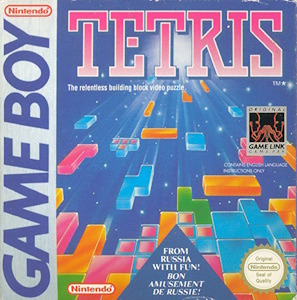Tetris (1989-)
Tetris was developed by Russian software engineer Alexey Pajitnov and originally released in 1984. Created while Pajitnov was working at the Soviet Academy of Sciences in Moscow, Tetris quickly became one of the most iconic and widely recognized video games in history. The game’s simple yet addictive puzzle mechanic, involving the arrangement of falling geometric shapes called tetrominoes to clear horizontal lines, captured players’ attention around the world. Early on, it was published and distributed on various Soviet computer systems, eventually catching the eye of international publishers who helped bring it to a global audience.
The game has been ported to virtually every platform imaginable, from early computers like the IBM PC and Commodore 64 to handheld devices such as the Nintendo Game Boy, which played a significant role in popularizing the game outside of the Soviet Union in the late 1980s and early 1990s. Other notable releases include versions for consoles like the Nintendo Entertainment System (NES), Sega Genesis, and later modern platforms including smartphones and web browsers. The soundtrack, especially in versions like the Game Boy release, featured catchy tunes such as the famous Russian folk song "Korobeiniki," which became instantly associated with Tetris and contributed greatly to its cultural impact.
Tetris did not have any prequels, as it was an original concept that essentially created its own genre of block-dropping puzzle games. The game's promotion initially relied on word of mouth and its viral appeal rather than traditional marketing campaigns. However, once companies like Nintendo got involved, Tetris was aggressively marketed as a must-have title, particularly when bundled with the Game Boy in 1989. This pairing helped cement the game’s legacy and introduced it to millions of new players around the world.
Reception to Tetris was overwhelmingly positive from the start. Critics and players alike praised its elegant design, intuitive gameplay, and the way it challenged players’ strategic thinking and reflexes. It has been credited with revolutionizing the puzzle genre and is frequently cited as one of the greatest video games of all time. Its simple premise combined with endless replayability has ensured Tetris’ lasting popularity across generations, making it not just a game but a timeless cultural phenomenon.
Images from MobyGames
Buy Tetris
Click one of the Ebay or Amazon buttons below to check the latest prices and purchase Tetris for that particular platform.


Related Searches
Tetris is available to purchase and download from a range of vendors. Always shop....
Tetris may be available to download as abandonware from one of the many sites that offer this...
There are various sites out there that can offer cheat codes for games. Search now to find all available...
There are many sites out there that have collated and documented historic reviews of this game. Search now...
We don't host or link to rom sites for this game. However, there are many sites out there that may be...
The initial release date for Tetris on the NES is stated as November 1989. Other ports of the game may....
Tetris is available to purchase and download from the link(s) shown further up this....
There are multiple sites around the internet that offer visual guides to this game. Search now to find the....








